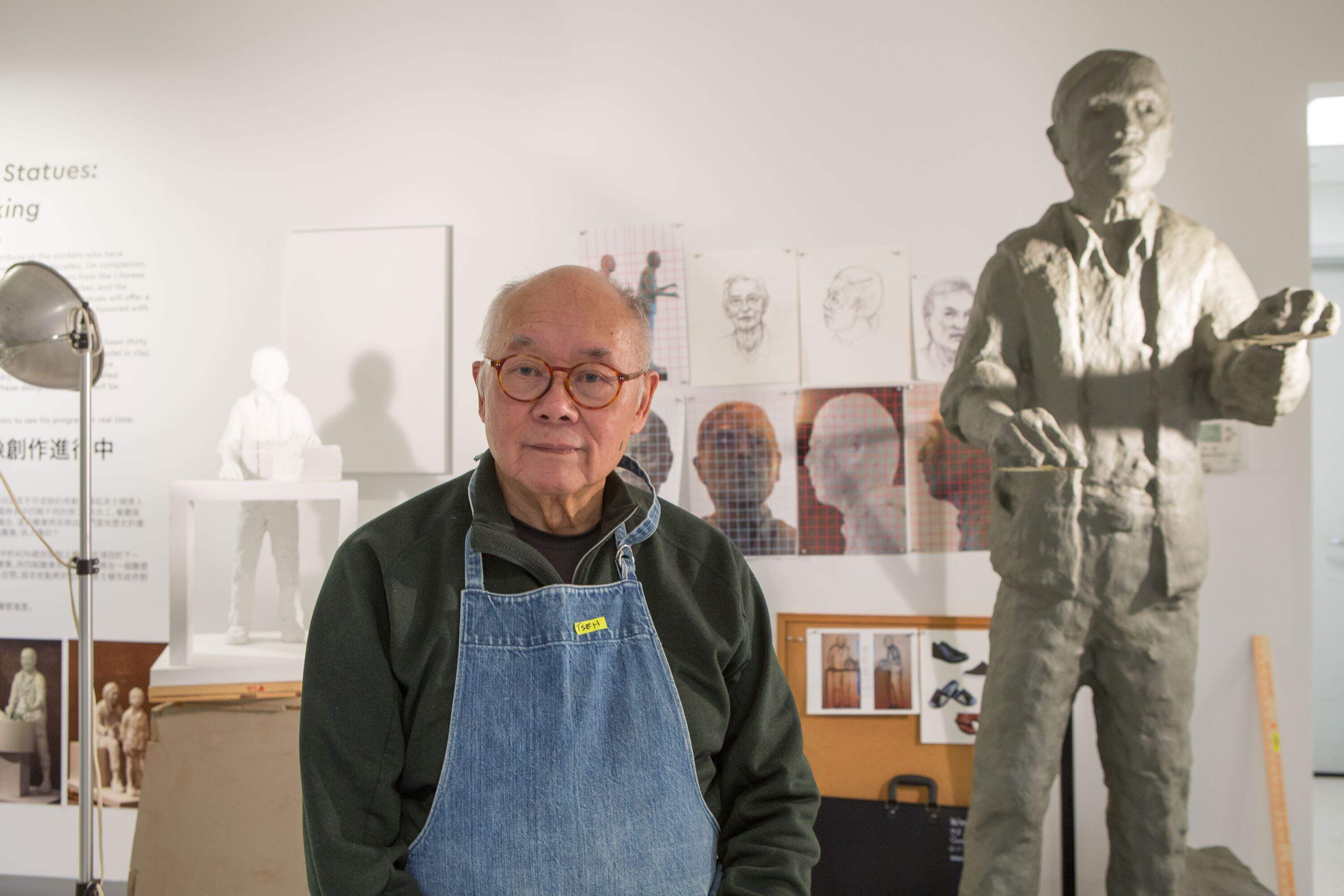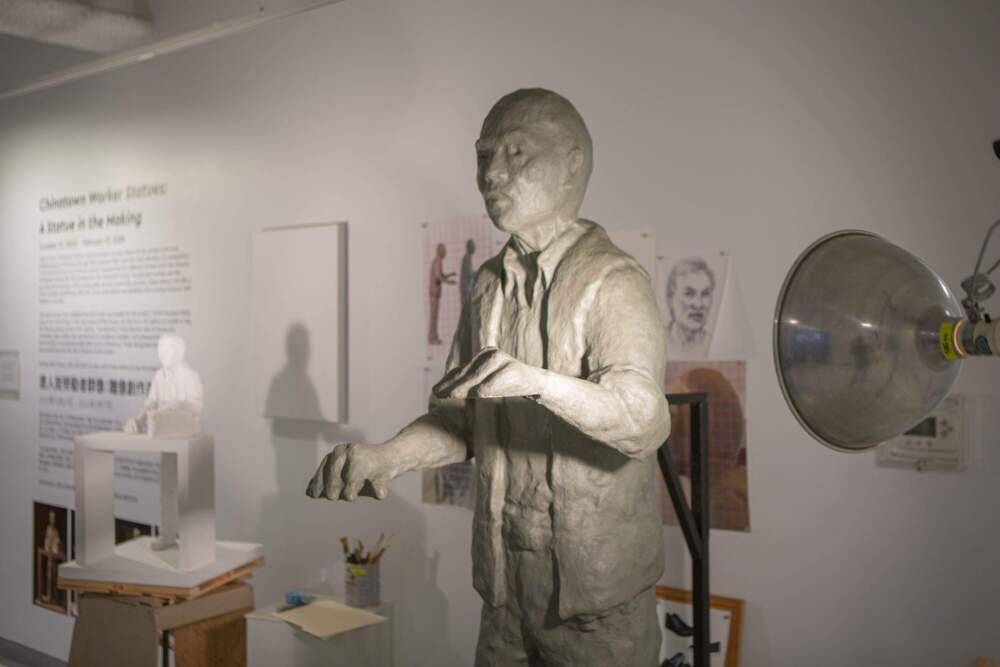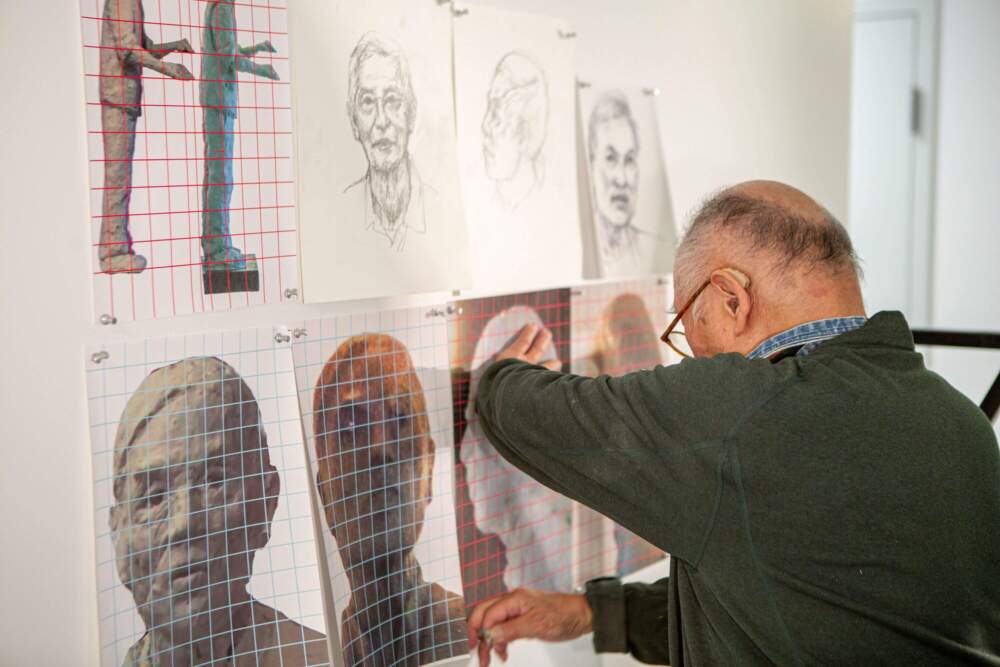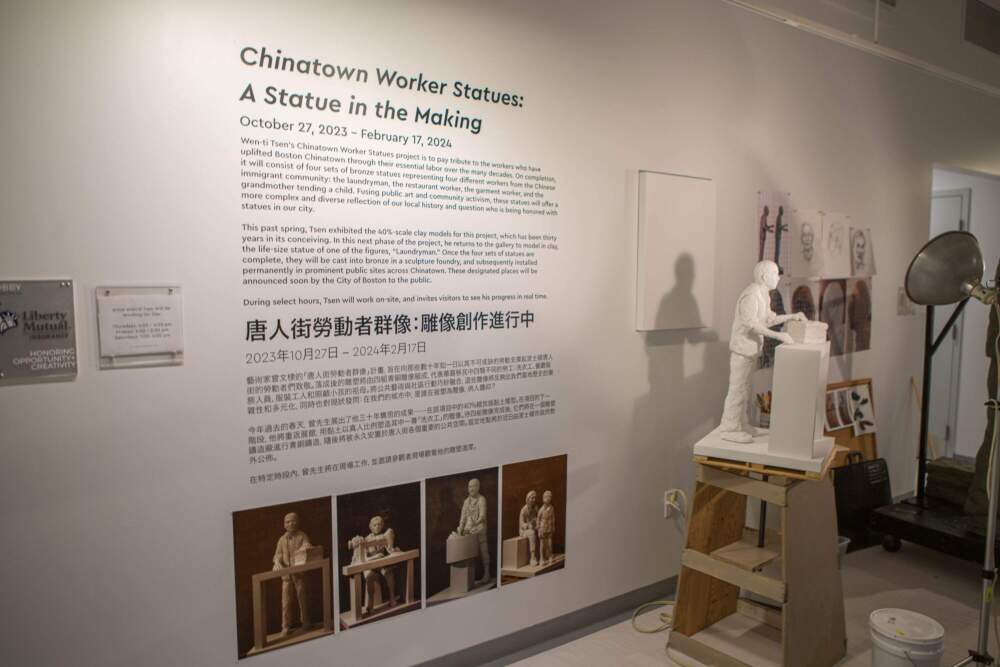Advertisement
Field Guide to Boston
In Chinatown, an artist makes monuments to the people who built the neighborhood

On a November afternoon, Wen-ti Tsen stood in the Pao Arts Center in Chinatown, peering skeptically at a large foam man. The larger-than-life figure stared vacantly, arms stretched out in front of him.
“I'm not very happy with it,” Tsen said. “I keep thinking of Mary Shelley's Frankenstein … who's just wandering around, looking for a victim.”
Nearby, a smaller version of the statue, molded in clay, revealed why his doppelganger seemed to be groping the empty air: underneath his hands was a table, and on it, a neat pile of laundry. He wasn’t a zombie. He was a laundryman.

The giant foam zombie-laundryman was part of a project, by Tsen, depicting Chinese workers throughout American history. Ultimately, four statues will be cast in bronze and installed throughout Chinatown – an homage to the ordinary people who built the neighborhood, rendered in the same monumental material as the statue of Washington astride his horse that towers over the Public Garden.
Tsen’s Chinatown Worker Statues project was recently awarded $1 million from the Mayor’s Office of Arts and Culture. A large portion of the grant will be used to fund the costly installation of the statue bases. The Chinatown Community Land Trust, a partner on the project, is helping to identify potential sites.
So far, Tsen has completed four small clay models of his planned statues, which depict a laundryman, a restaurant worker, a garment worker and a grandmother caring for a child.
“The four figures are based on Chinese workers traditionally in America for the last 200 years,” Tsen explained. “At first, because of the discrimination, they were not allowed to have any jobs or own any business.”
Tsen, 88, is a longtime Boston area painter, public artist and activist. He drew on oral histories conducted for previous art projects to conceptualize the four archetypal Chinatown workers. The laundryman and restaurant worker represent occupations commonly held by male immigrants in the late 19th and early 20th centuries. The end of the Chinese Exclusion Act in 1943, followed by immigration reform in the 1960s, meant that men could finally bring their families to the States, where women found work in garment factories and grandparents cared for children.
Advertisement

Each of Tsen's figures looks up from their task as if caught in a reverie. The garment worker sits behind a sewing machine, eyes cast into the distance.
“It's that split second that she has got hold of her humanity,” Tsen said. “The work doesn't dominate her.”
Tsen explained that women often worked long daytime hours in the garment factories, while their husbands worked restaurant shifts that ran late into the night. Caretaking fell to grandparents, who developed close bonds with their charges.
In one of Tsen’s statues, a grandmother holds her knitting on her lap while her eyes are trained her granddaughter standing a few paces in front of her. The little girl faces away, body tilted slightly forward. “She has the grandmother behind her, but her future is in front of her,” Tsen said.
Tsen worked off of human models to create his workers, taking care not to make them look too much like their real-life inspirations. It was a delicate balance: the statues needed to represent a whole class of worker, but still remind someone of her own parent or grandparent.
“I can easily sentimentalize any one of them,” Tsen said. “But I think it's very important not to do that, so that people can relate to it rather than seeing it as a drama.”
And, he explained, it was important to convey a sense of agency in these figures, even though they are performing work considered menial. That is why he depicted the laundryman with one hand resting possessively on the stack of folded clothes.
“I want him, the statue, to [show] that he has control over what he has created, what he has cleaned,” Tsen said.
He explained that immigrants often had to travel far outside the city to find employment – the suburbs, or even to New Hampshire or Vermont. The laundryman might have been the only Chinese person in the small New England town where he worked. Tsen imagined he would have found small ways to assert his humanity when faced with racist or dismissive customers.
“He has no way of writing down their names, even … so he often describes it in Chinese on the packet that he sent back to the person. You know, ‘the person with a mole on his cheek.’ I mean, worse than that,” Tsen said. “It's an indication, and it's also a way of controlling his life, overcoming some of the prejudices that he faces.”
Three days a week, Tsen spends a couple hours working on the laundryman in the foyer of the Pao Arts Center. The exhibition, which runs through Feb. 17, is designed so the public can see his process as it unfolds.
“I think it kind of breaks down, a little bit, the mystique of the sculptor in a studio, or that very Western notion of the master artist,” said Pao Arts Center’s director, Cynthia Woo.
She added that the exhibition created an opportunity to educate visitors about Chinese-American history.
“Many people don't know the history of labor,” Woo said. “So it really provides an interesting gateway to talk about these underrepresented stories and histories that aren't really taught in schools. And it's a very tangible way for people to connect.”

The exhibition also lets the public into the sometimes arduous process of making art. The full-sized laundryman statue was rendered in foam based on a digital scan of the small model, and then sprayed in a thin layer of clay. It’s pretty accurate, but not very detailed. Tsen’s task during his four-month residency is to refine the features on the large model so it can be used to make a mold for the bronze statue.
By mid-December Tsen’s progress was evident. Deeming the head too big for its body, he had removed the laundryman’s expressionless foam dome and carved it down to size. It sat on a table in the Pao Arts Center foyer. Nearby, a red crock pot softened the clay so Tsen could apply it to the statue’s face, transforming him from a zombie into a man.
“Like this nostril here. If I move it one way or the other, it can change his expression,” Tsen explained. “At the moment it looks kind of disdainful, but this will sort of modify it… He should not be congenial because the hard work doesn't make a person very friendly.”
Tsen was much happier with the statue already. The posture was closer to what he envisioned: stooped, but not abject.
“It's a little bit solicitous, this laundry man, I want him to be,” Tsen said. “At the same time he should have a lot of pride inside.”
He wanted Chinatown residents to feel a sense of pride when they passed the statue on the street.
“The Chinatown community gets to be quite downtrodden … but I would like even for the older people to see [that] we don't have to be like that,” Tsen said. “And especially for younger people to feel that our ancestors have a lot of dignity inside them.”
"Chinatown Worker Statues: A Statue in the Making" runs through Feb. 17 at Pao Arts Center.
This segment aired on January 17, 2024.
